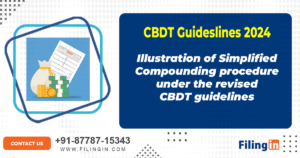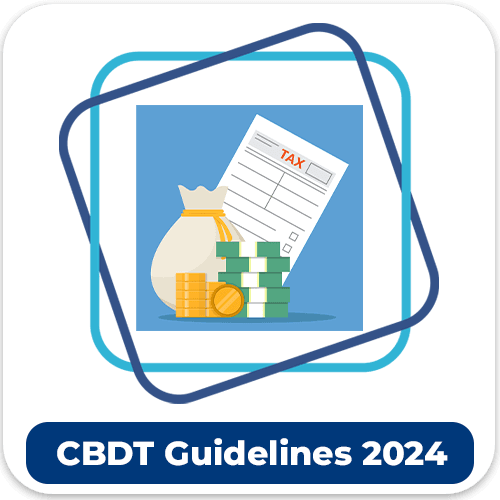On October 17, 2024, the Central Board of Direct Taxes (CBDT) unveiled its revised guidelines for the compounding of offences under the Income-tax Act, 1961. These new guidelines are a significant step forward in simplifying the tax compounding process and reducing charges, aligning with the Finance Minister’s recent budget announcement.
These revised guidelines replace all previous instructions and are applicable to both pending and new applications from the date of issue. The changes aim to ease the compliance burden on taxpayers by removing complexities, rationalizing compounding fees, and offering a more streamlined process for resolving tax-related offences.
Let’s take a closer look at what these changes mean for taxpayers and how they impact the overall compounding procedure.

What is Compounding of Offences under the Income-tax Act?
Before we dive into the revised guidelines, it’s essential to understand what compounding of offences means. In simple terms, compounding allows an individual or entity to settle an offence by paying a compounding fee instead of facing prosecution. This is typically used to resolve minor offences under the Income-tax Act, such as failure to pay TDS (Tax Deducted at Source) or non-filing of returns.
Compounding offers a quicker, less stressful way for offenders to resolve their tax issues without enduring a lengthy legal process.
Key Highlights of the Revised Guidelines
The revised guidelines simplify the compounding process by introducing several key changes. Here are the most important highlights:
1. Elimination of Offence Categorization
Previously, offences were divided into two categories for compounding: “technical” and “non-technical.” Under the revised guidelines, this categorization has been completely eliminated. This helps simplify the process, reducing the burden of classifying offences and making the procedure more accessible.
2. No Limit on Number of Applications
One of the major changes introduced in the revised guidelines is the removal of the limit on the number of times a taxpayer can file for compounding. Earlier, taxpayers were restricted in how often they could apply for compounding of offences. With this limit removed, individuals and companies can now file multiple applications if needed, provided they fulfill all the necessary criteria.
3. Fresh Applications Upon Curing Defects
Under the previous guidelines, taxpayers could not file fresh applications if there were defects in the original filing. The new guidelines allow for fresh applications once defects are cured, which means taxpayers now have a second chance to comply with the requirements without being disqualified outright.
4. Removal of Time Limit for Filing Applications
Earlier, taxpayers had a window of 36 months from the date of filing the complaint to submit their compounding applications. This time limit has now been removed. Taxpayers can file for compounding at any time, allowing for greater flexibility and reducing the pressure to meet strict deadlines.
5. Compounding for Section 275A and 276B Offences
The revised guidelines also introduce provisions for compounding offences under Section 275A (removal, concealment, or transfer of property to thwart tax recovery) and Section 276B (failure to pay tax deducted at source). Previously, these sections were excluded from compounding, but they are now eligible, offering a broader scope for resolving offences.
6. Simplified Compounding Process for Companies and HUFs
The new guidelines make it easier for companies and Hindu Undivided Families (HUFs) to compound offences. Under the previous system, only the main accused could file the application. Now, the main accused, as well as any or all co-accused, can apply for compounding by paying the relevant charges. This flexibility is a major boon for organizations, allowing them to resolve tax issues without waiting for the primary accused to act.
7. Rationalization of Compounding Charges
One of the most welcome changes is the rationalization of compounding charges. The rates have been significantly lowered for various offences. For instance, TDS defaults, which previously attracted rates of 2%, 3%, and 5%, have now been reduced to a uniform rate of 1.5% per month.
8. Abolition of Interest on Delayed Payment of Charges
Previously, interest was charged on delayed payments of compounding fees, further burdening taxpayers. The revised guidelines abolish this interest charge, making it more cost-effective for taxpayers who are unable to pay immediately.
9. Simplified Calculation of Charges for Non-Filing of Returns
The revised guidelines have also simplified the method for calculating compounding charges related to non-filing of tax returns. This will help ensure that taxpayers are not overwhelmed by complicated fee structures and can resolve their issues more efficiently.
10. No Separate Charges for Co-Accused
Another important simplification is the removal of separate compounding fees for co-accused individuals in a case. Now, the compounding charge is paid by the main accused and applies across all related parties, reducing the overall financial burden.
Impact on Taxpayers
The revised guidelines are designed to offer relief to taxpayers by streamlining the process and lowering financial costs. By removing multiple guidelines and simplifying the application process, CBDT has made it easier for both individuals and businesses to comply with tax regulations.
1. Reduced Financial Burden
Lower compounding rates and the removal of interest on delayed payments significantly reduce the financial impact on taxpayers. This encourages taxpayers to come forward and resolve their offences without the fear of excessive fees.
2. Flexibility in Filing Applications
The removal of limits on the number of applications and the time limit for filing compounding requests provides taxpayers with more flexibility. This is especially beneficial for those dealing with complex tax issues or facing delays in resolving their tax matters.
3. Enhanced Compliance
By simplifying the compounding process, the revised guidelines promote better compliance among taxpayers. The easier and more affordable the process, the more likely individuals and businesses will follow through with the necessary procedures.
How to Apply for Compounding Under the Revised Guidelines
To apply for compounding under the revised guidelines, taxpayers must follow a straightforward procedure:
- File an Application: Submit the compounding application along with relevant documents to the CBDT.
- Pay the Compounding Charges: After the application is approved, pay the calculated compounding charges based on the offence.
- Receive Resolution: Once the charges are paid, the offence is considered compounded, and further legal action is halted.
The process has been simplified under the new guidelines, making it more accessible to taxpayers who may have been hesitant in the past.
Conclusion
The revised guidelines for compounding offences under the Income-tax Act, 1961, are a welcome move by the CBDT. By removing complexities, lowering charges, and providing greater flexibility, these changes aim to foster better compliance and offer relief to taxpayers. Whether you’re an individual, a business, or part of a larger organization, the new guidelines provide a simpler, more affordable way to resolve tax-related offences.
For more details on the revised guidelines, you can visit the official Income Tax Department website at incometaxindia.gov.in.
Frequently Asked Questions (FAQs)
1. What is the major change in the revised guidelines for compounding?
The major change is the elimination of offence categorization and the removal of the time limit for filing compounding applications.
2. Can offences under Sections 275A and 276B now be compounded?
Yes, offences under Sections 275A and 276B, which were previously non-compoundable, can now be compounded under the revised guidelines.
3. How have compounding charges for TDS defaults been changed?
The rates for TDS defaults have been reduced from multiple rates (2%, 3%, 5%) to a single rate of 1.5% per month.
4. Is there a time limit for filing a compounding application?
No, the revised guidelines have removed the 36-month time limit for filing compounding applications, providing more flexibility.
5. How does the new process simplify compounding for companies and HUFs?
The requirement for only the main accused to file the application has been removed. Now, both the main accused and co-accused can file and pay the compounding charges.

